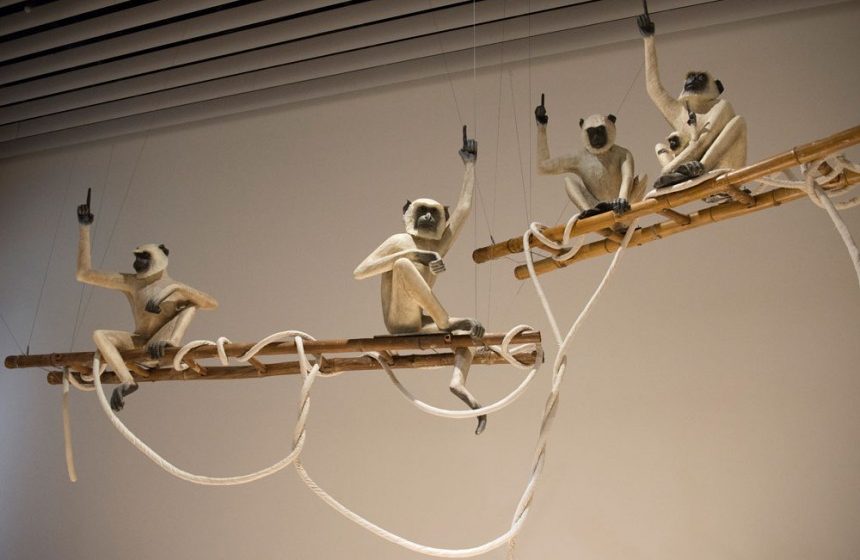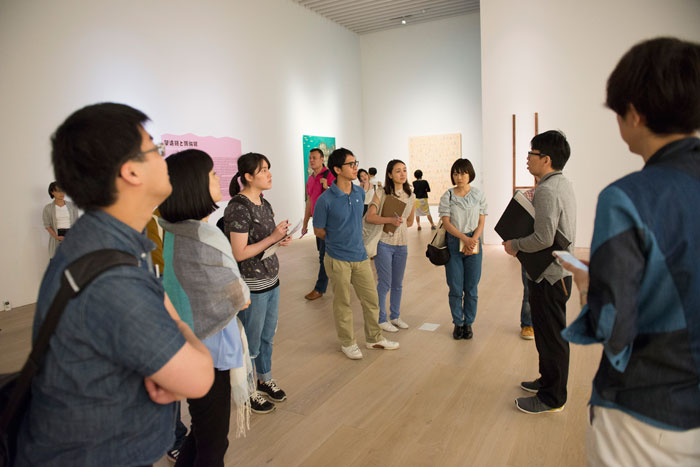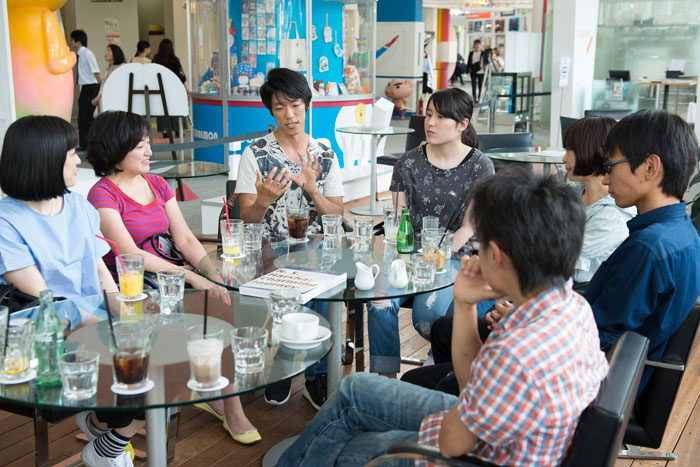In June 2017, an art appreciation event was held at Mori Art Museum in Roppongi. This workshop, which encouraged the enjoyment of freely appreciating art, brought together people from diverse backgrounds and with different values. Drawing out the participants’ powers of imagination and expression through careful observation of the exhibited works, various opinions and perspectives were shared as they communicated about their experiences. On this occasion, everyone viewed the solo exhibition N. S. Harsha: Charming Journey by N. S. Harsha (born in 1969), an artist from southern India. Guided by museum staff in charge of the art education program, participants freely discussed their thoughts and feelings in front of the exhibited work. The participants included staff of NPO Hinatabokko, recipients of social care, foster parents, illustrators, and art university students. Dividing into groups of adults and children, everyone enjoyed the exhibition, .
Who is N.S. Harsha?
The participants learned about N.S. Harsha’s name, and the culture and religion of Mysuru, which is his birthplace and the ancient capital of southern India, by listening to stories about Indian gods and looking at various photos of the city. For Harsha, who lives in a region where animals and humans live in close proximity to one another, animals are a daily sight, and frequently appear in many of his works.

N. S. Harsha, “We Come, We Eat, We Sleep” (detail) 1999-2001. Synthetic polymer paint on canvas.
Installation view: “N.S. Harsha: Charming Journey”, Mori Art Museum, 2017. Photo by Takaaki Asai.
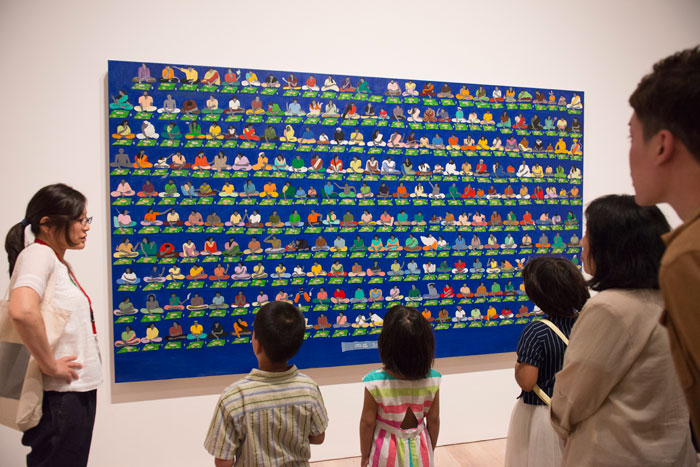
N. S. Harsha, “We Come, We Eat, We Sleep” (detail) 1999-2001. Synthetic polymer paint on canvas. Installation view: “N.S. Harsha: Charming Journey”, Mori Art Museum, 2017. Photo by Takaaki Asai.
Looking closely at the recurring motifs, it became clear that each gesture and facial expression was distinctive. “This person is doing something different.” “There’s an animal!” The more the participants looked, the more their imaginations expanded.
Harsha re-examines what has been taken for granted, broadening his thoughts to reflect on people, ways of living, society, the economy and the universe. In addition, his expressive style, which involves the depiction of numerous people and animals in a single painting, generates a unique rhythm. Looking at each work in its entirety, the subjects appear as a single group, yet the expressions and gestures of each figure is different. This series of work reflects the diverse languages, religions and cultures of India, while also bringing the viewer to consider the relationship between individual and group.
“Why aren’t they smiling?”
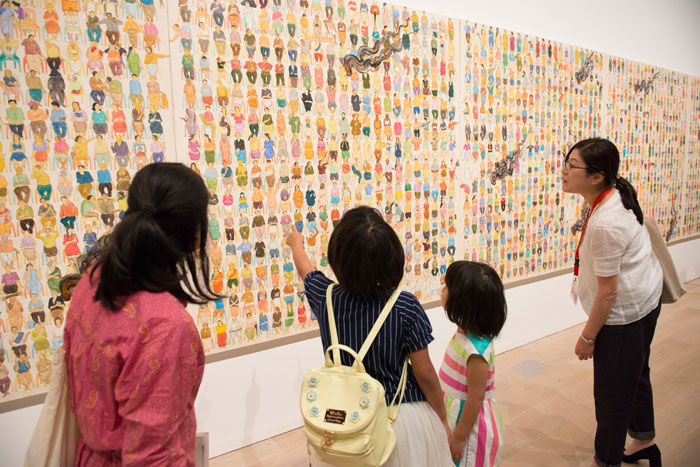
N. S. Harsha, “Come Give Us a Speech”, 2008, acrylic on canvas.
Installation view: “N.S. Harsha: Charming Journey”, Mori Art Museum, 2017. Photo by Takaaki Asai.
“Why so many faces?”
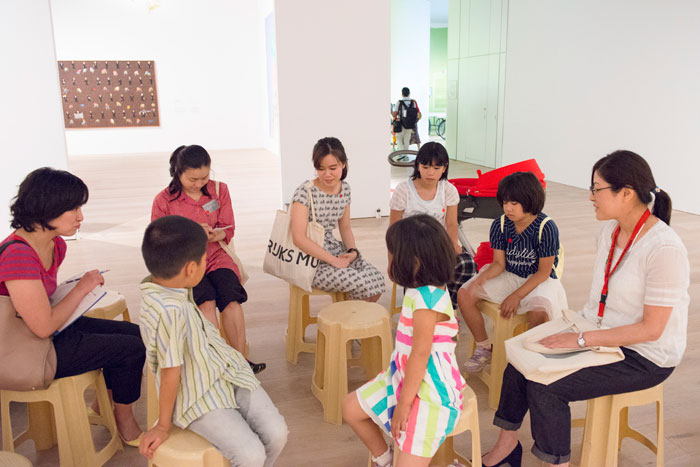
Participants exchanging opinons. “N. S. Harsha: Charming Journey”, Mori Art Museum, 2017. Photo by Takaaki Asai.
The participants discussed the facial expressions of figures in Harsha’s paintings. The museum staff explained that happiness and the future are central themes in his work. Closer observation of the paintings revealed that the people portrayed did not appear to be particularly happy. The participants exchanged contrasting views, one suggesting that it could be due to cultural differences, and that smiles or happiness may be expressed in different ways, while another reflected that few paintings in the world show figures with ‘beaming smiles.’

N. S. Harsha, “Sky Gazers”, 2010 / 2017, acrylic on plywood.
Installation view: “N.S. Harsha: Charming Journey”, Mori Art Museum, 2017. Photo by Takaaki Asai.
Memorable shots were taken when participants joined the people drawn by Harsha. Children enjoyed the mirror on the ceiling, racing each other while facing upwards to see who could go the farthest as they kicked the walls.
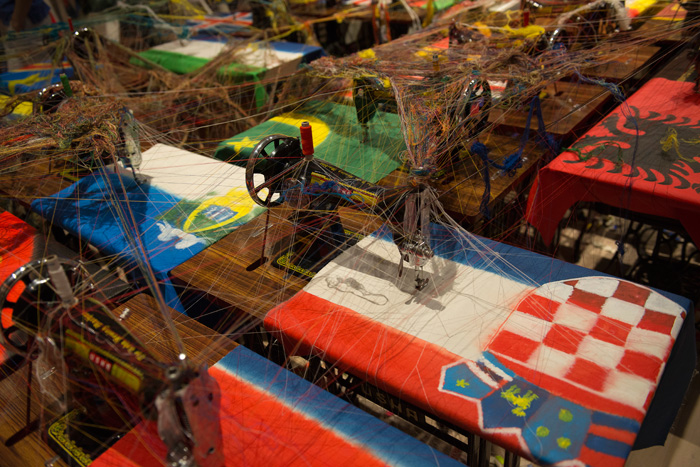
N. S. Harsha, “Nations” (detail), 2007 / 2017, 193 foot-operated sewing machines, acrylic on canvas, dimensions variable.
Installation view: “N.S. Harsha: Charming Journey”, Mori Art Museum, 2017. Photo by AIT.
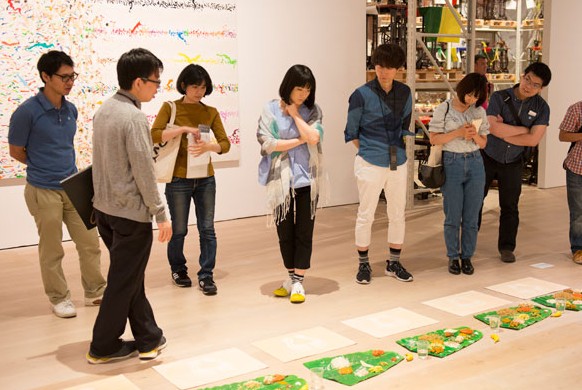
N. S. Harsha, “Leftovers” (detail), 2008 / 2017, acrylics, plastic resin, canvas Dimensions variable.
Installation view: “N. S. Harsha: Charming Journey,” Mori Art Museum, 2017. Photo by Takaaki Asai.

N. S. Harsha, “Leftovers” (detail), 2008 / 2017 Acrylics, plastic resin, canvas. Dimensions variable. Installation view: “N. S. Harsha: Charming Journey,” Mori Art Museum, 2017. Photo: Shiigi Shizune. Photo courtesy: Mori Art Museum, Tokyo.
This is a work of art that shows traditional Indian repast on a banana leaf, which the artist made in collaboration with a Japanese company that produces plastic food sample displays.
“Have these meals been left, or are they about to be eaten? Which do you think?”
“There are many here, so they are about to be eaten!”
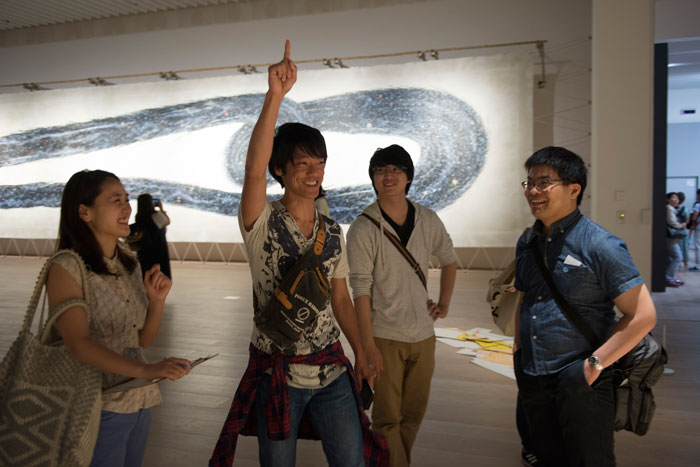
N. S. Harsha, “Punarapi Jananam Punarapi Maranam (Again Birth, Again Death)” (detail), 2013, acrylic on canvas, tarpaulin.
Installation view: “N. S. Harsha: Charming Journey”, Mori Art Museum, 2017. Photo by Takaaki Asai.
Tea Time Discussion
After the workshop, some of the adults went to have tea. They reflected on the workshop, talking about the works of Harsha and contemporary art in general.
The participants in the tea time session included an organizer of a child-care facility, university students, and illustrators. With varying levels of familiarity with contemporary art, each of them talked about what they found interesting and difficult about art. There were differing views: one person referred to the ambiguity of value in contemporary art; another person spoke about the importance of having explanations provided for artwork; another found this exhibition interesting as it engaged in social themes that were not easily accessible. For the art university students, it provided an opportunity to think about art appreciation, an activity that may lose importance through the course of studying art.
For the children, this was their very first time to visit a museum, and this alone was enough to make this a special experience for them. For the adults, the experience brought new discoveries and perspectives, as they viewed art together with people from different fields—those who specialize in art and those who don’t—and shared opinions and feelings through dialogue.
Text:Miho Shimizu
After hearing the explanation that Harsha was also portrayed in the painting, a boy was surprised and asked: ‘What? We can paint ourselves in the picture?’ That left a strong impression on me.
Support StaffI am studying art, so it was refreshing to see paintings from different perspectives. I was particularly shocked to hear the opinion that despite the bright colors, the art pieces gave out a dark impression as there were almost no figures smiling in the paintings.
Art University StudentMori Art Museum: Eise Shiraki, Eriko Shirahama, Sumika Takashima
Hinatabokko: Takayuki Watai
AIT: Rika Fujii, Shoko Aoki
Support Staff: Yuki Azuma, Minari Sasaki, Miho Shimizu
Photography: Takaaki Asai
Date: June 3, 2017 (Sat)
Time: 2pm-5pm (art tour: 2pm-4pm / tea time: 4pm-5pm)
Location: Mori Art Museum, Exhibition Space
Organizer: NPO Arts Initiative Tokyo/AIT
Co-Organizer: The Nippon Foundation
Cooperation: Mori Art Museum, NPO Hinatabooko
-
About the exhibitionN. S. Harsha was born in 1969 in southern India's ancient capital Mysuru, where he continues to reside and pursue his artistic practice. India's fast-paced economic development and urbanization in recent years has also raised the international profile of its contemporary art, and over the past decade N. S. Harsha has presented his work at numerous international exhibitions. Simultaneously, he has carved out his own highly idiosyncratic place in the world by engaging frankly with the diversity of “life” around him, from the traditional culture and natural environment of southern India, to the everyday relationships between people, flora and fauna.
Encompassing Harsha's major works since 1995, this first mid-career retrospective will explore themes running consistently through his practice, such as the absurdity of the real world, representation and abstraction, and repeating images. The exhibition will be one in a continuing series of solo exhibitions at the Mori Art Museum featuring mid-career artists from Asia, while showcasing contemporary art from rapidly developing nations and regions such as China, Africa, India and the Middle East. (Excerpt from the museum website.) -
NPO HinatabokkoHinatabooko is a specified non-profit organization focused on two central activities: the administration of spaces and provision of counseling for those who have left or are about to leave children's homes, and the gathering of voices of concerned parties in order to raise public awareness about social care. Based on the running of Hinatabokko Salon, the organization seeks to support the recipients of social care who use the salon in order to encourage self-esteem as well as create a society in which growing up in care does not lead to disadvantage.

